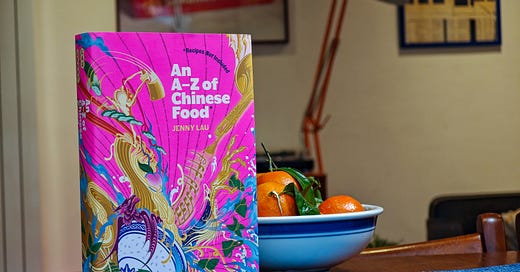I’m beginning to suspect I’ll need to rename the ‘cookbooks’ section of the site, because here I am, reviewing my third book which is no such thing.
Jenny Lau’s An A-Z of Chinese Food, which began life as an online writing project but is now collected in print, is quite consciously not a Chinese cookbook. As Lau herself notes on its penultimate page, she “vowed not to include a single recipe,” which she calls “an act of resistance” to pressure from publishers to make her book more commercial. Reading this book will not teach you much about making Chinese food of any stripe, and in fact I’d go so far as to say that it probably won’t teach you much about Chinese food at all.
Instead, like London Feeds Itself (to which Lau actually contributed a chapter) this is an assortment of essays that take food as a starting point, a lens through to explore culture and family and immigration and colonisation and a hundred other things along the way. Lau’s jumping off point is Chinese food, and more specifically the Chinese diaspora’s relationship with it, how food — more than anything else — so often becomes the central element through which people relate to their Chineseness.
In case you’ve not met me in person, this might be an opportune moment to point out that I am not Chinese, nor any other stripe of East or Southeast Asian (ESEA). Any connection I have to that community comes solely through my partner Vivian, thanks to whom I am learning Mandarin; celebrate Chinese New Year; and am slowly, haltingly, getting better at wrapping dumplings. It’s fair to say, then, that I’m not really the target audience for An A-Z of Chinese Food, but I’m not a million miles away from it either.
Learning to speak Mandarin has proven a particular primer. Lau opens the book with a few pages of explanation of how she approaches translating and romanising words from both Cantonese and Mandarin, but language runs deeper than that here. In ‘V is for Vegan’ she explores what changes when we approach identity labels as verbs, in ‘S is for Schezwan’ she traces the intertwined roots of Indo-Chinese food and a very specific spelling. Lau questions what it means that she defaults to the Mandarin ‘zongzi’ rather than the Cantonese ‘joong’, and devotes whole chapters to breaking down words like ‘ch*nk’ and ‘Oriental’, while earnestly grappling with the upsides and downsides of modern pan-Asian labels like ESEA.
Keep reading with a 7-day free trial
Subscribe to Braise to keep reading this post and get 7 days of free access to the full post archives.







